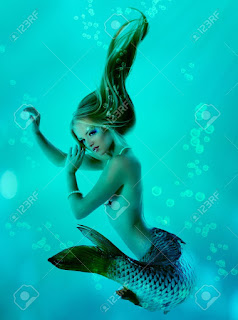 |
| Mermaid Underwater Mythology |
Kelpie
Kelpie or water kelpie is the name given to a shape-shifting water spirit inhabiting the lochs and ponds of Scotland. It is described as a horse but can change to human form. Some reports say that it retains its hooves when in the human form. The origin goes back to possible human sacrifices once made to appease the water gods, but its practical use in keeping young children away from bodies of water. Described as a powerful and beautiful black horse. Its hooves are reversed in comparison to normal horses. Kelpies take their victims into the water, devour them, and throw the entrails on the bank. When they shape shift to humans they have water weeds in their hair. Kelpies in their human form are male. A bridle taken by from a kelpie was endowed with magical properties, and if brandished towards someone, would make that person a horse or pony.
Neck (water spirit)
Also referred to as nicor, nixie or nokken. They are shape-shifting water spirits who usually appeared in forms of other creatures. Nix was a German male while Nixe was a female river mermaid. Sometimes appeared as a man playing a violin, the most common animal form was that of a “brook horse.” He was thought to be active on Thursdays. By calling their name caused their defeat or death however, other stories relate that a piece of steel and the sign of the cross will cause them to disappear.
Siren
Popular in Greek mythology, Sirens were dangerous creatures who would lure sailors with music and singing. In luring the ships they would cause them to wreck on the rocky coasts of the islands they inhabited. Their appearance is that of a woman and a bird in a variety of ways. Early stories portray them as birds with large women’s head, bird feathers, and scaly feet. Later, they appeared as female figures with legs or birds, with or without wings, playing a variety of musical instruments, especially harps.
Mermaid
In folklore, the mermaid is a creative with a female upper body and the tail of a fish. There presence in folklore spans many cultures including Near East, Europe, Asia, and Africa. They are associated with perilous events such as floods, storms, shipwreck, and drownings. However, they can be nice, bestowing boons or falling in love with humans. The male is called a merman but their sightings are less common than mermaids. Sirenomelia is a rare congenital disorder in which a child is born with his/her legs fused together, it is also called “mermaid syndrome.” They consider fish to be sacred, and they never eat them. They eat fowl, but do not eat the dove because they believe it is holy. They can and do interbreed with humans and their offspring have the ability to live underwater.
Herb of immortality or Elixir of life
A potion that grants the drinker eternal life and/or eternal youth as well as cure all diseases. In India, it is called Amrita and believed that it could only be gained from the samundra manthan (or churning of the ocean) for in the deep waters and secret objects. In Europe, the Elixir of Life is closely related to the creation of the philosopher’s stone. Some believe it is a metaphor for the spirit of God. In Japan, the serpent bathes in the water of life and this is why serpents can rejuvenate themselves each year by shedding their skin while men are doomed to die.
IMAGE - picture of a mermaid
No comments:
Post a Comment